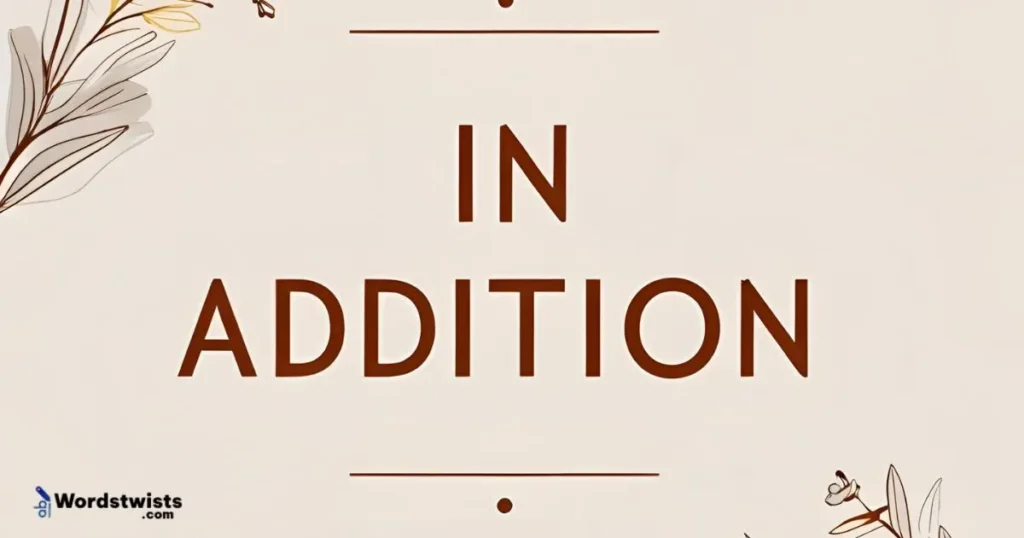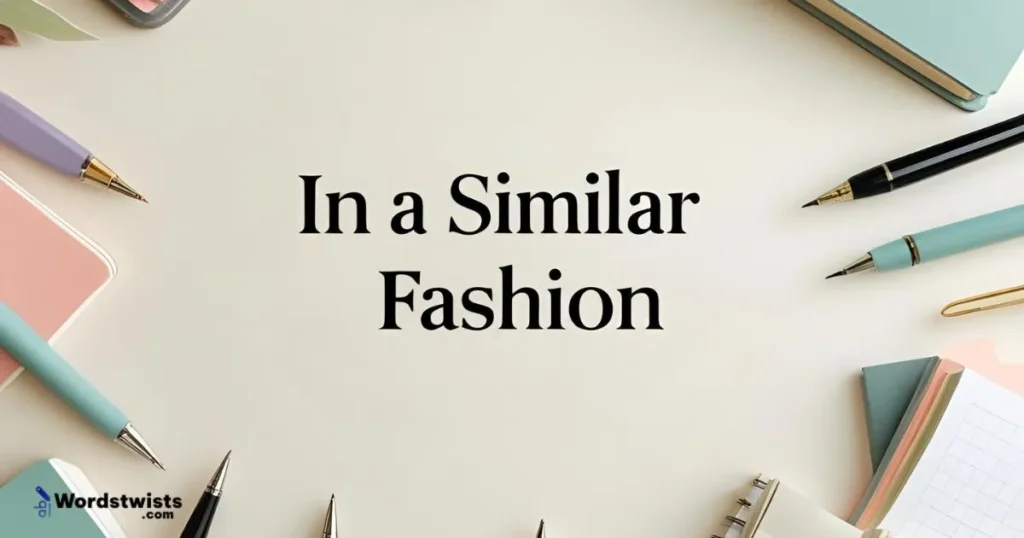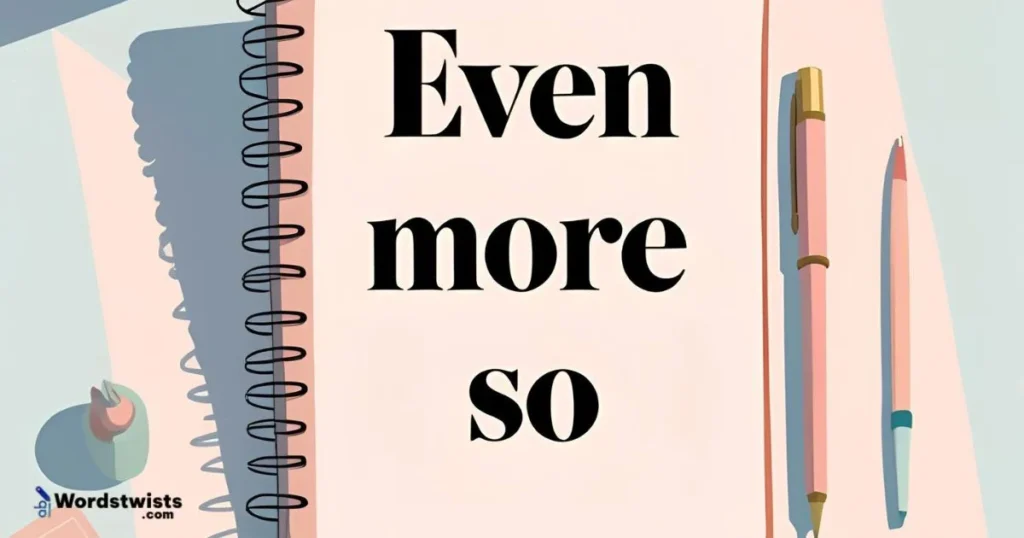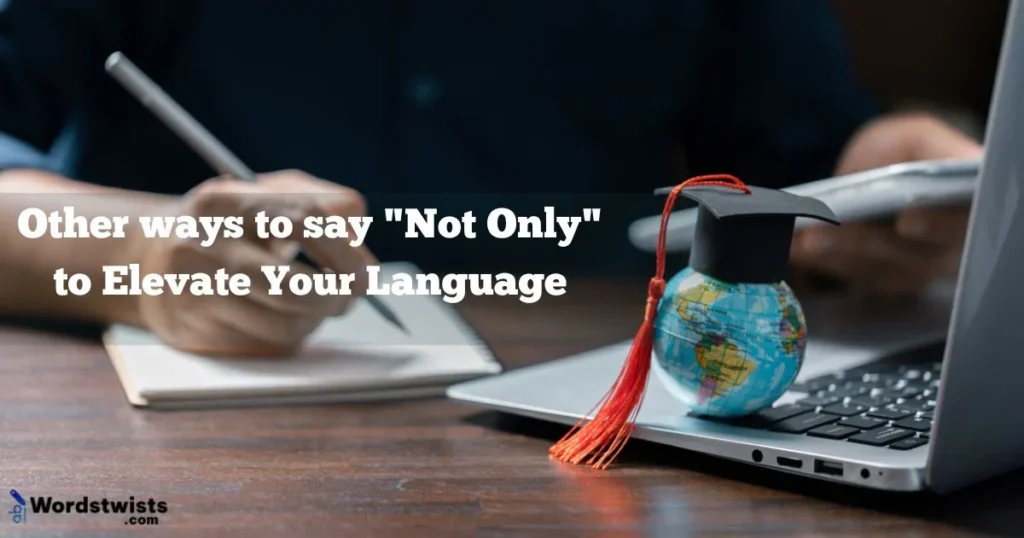Are you tired of hearing the same phrase, “Not Only,” repeated over and over? It can make your writing or speech feel stale and repetitive. The good news is, there are plenty of fresh, exciting alternatives to this phrase that can bring your communication to life! Whether you’re writing an essay, giving a presentation, or simply having a conversation, these 25 alternatives will help you stand out, sound more professional, and keep your audience engaged.
In this post, we’ll explore 25 alternatives to “Not Only” that can take your vocabulary to the next level. By replacing the phrase with these powerful alternatives, you’ll be able to communicate with more flair, creativity, and precision. So let’s dive in and discover how you can easily incorporate these alternatives into your writing and speech to sound more polished and dynamic!
Not Only – Meaning
The phrase “not only” is used to emphasize that one statement is true while indicating that there is an additional point or quality to consider, often paired with “but also.” It highlights more than one fact, quality, or action, showing that both are important or surprising. For example, in “She is not only talented but also hardworking,” it stresses that she is talented and, in addition, hardworking.
ways to say “Not Only”
1. Moreover
Explanation: “Moreover” adds extra emphasis, strengthening the point you’re making by introducing more compelling information.
Examples:
- She’s not only a fantastic designer, moreover, her marketing skills are exceptional.
- The weather is bad today; moreover, it’s expected to get worse.
- He’s a skilled programmer; moreover, he’s an excellent communicator.
- The presentation was clear and informative, moreover, it was engaging.
- Moreover, the company plans to expand internationally next year.
Why It Works: “Moreover” connects ideas and adds weight to the statement, making your argument stronger.
2. In Addition

Explanation: “In addition” is straightforward and commonly used to introduce additional information that builds on the previous point.
Examples:
- In addition, the new software will help improve efficiency.
- She not only teaches well, in addition, she inspires her students.
- The movie was entertaining, in addition, the soundtrack was amazing.
- In addition, we’re introducing a new customer loyalty program.
- The job requires strong communication skills, in addition, technical expertise.
Why It Works: “In addition” is versatile and works well in both formal and casual writing, linking ideas smoothly.
3. Besides
Explanation: “Besides” is often used informally to provide additional reasons or information, often with a conversational tone.
Examples:
- Besides, we can’t afford to wait any longer.
- He’s not just a great athlete, besides, he’s also a role model.
- Besides, the product is available at a lower price than expected.
- The weather was great, besides, we had an amazing time.
- Besides, we already have everything we need for the trip.
Why It Works: “Besides” is informal and creates a conversational tone, making it feel natural and easy to follow.
4. What’s More
Explanation: “What’s more” introduces additional information that often surprises or adds emphasis, drawing attention to something important.
Examples:
- He’s not only talented, what’s more, he’s incredibly humble.
- The restaurant has delicious food, what’s more, they offer live music.
- What’s more, the team finished ahead of schedule.
- The conference was enlightening, what’s more, it was fun.
- What’s more, the app is free to download.
Why It Works: “What’s more” heightens the impact of your point and adds emphasis, making your statement more engaging.
5. As Well
Explanation: “As well” adds an extra element to the sentence, typically used in informal contexts to imply something additional.
Examples:
- He’s a great cook, as well as being a talented musician.
- She enjoys running, as well as practicing yoga.
- As well, the company has plans to hire new employees.
- The children were excited, as well as the parents.
- I love hiking, as well as camping.
Why It Works: “As well” keeps things casual and fluid, making your writing feel more conversational and accessible.
Explore More: Other ways to say “Sorry for the short notice in an email
6. What’s Better
Explanation: “What’s better” introduces something even more impressive or exciting after presenting a point.
Examples:
- She’s a fantastic leader, what’s better, she’s also a mentor.
- The hotel has a pool, what’s better, it’s heated year-round.
- What’s better, the team met their goals and finished ahead of schedule.
- He’s not only a great speaker, what’s better, he’s also a fantastic listener.
- What’s better, the offer includes free shipping.
Why It Works: “What’s better” builds excitement and adds a sense of surprise or extra benefit.
7. In the Same Way

Explanation: “In the same way” is used to show that one idea or action mirrors another, drawing comparisons between them.
Examples:
- In the same way, the company improved its marketing strategy, the team worked on increasing product quality.
- She speaks several languages; in the same way, she’s a skilled writer.
- In the same way, the project was a success, the team’s efforts paid off.
- We improved efficiency in our operations, in the same way, we enhanced customer service.
- The initiative was successful, in the same way, our sales figures reflected positive results.
Why It Works: “In the same way” helps show parallels between two ideas, making the comparison clear and easy to follow.
8. To Add to That
Explanation: “To add to that” introduces additional, often complementary information, which enhances the initial statement.
Examples:
- The car is fuel-efficient, to add to that, it has great safety features.
- She’s an expert in her field, to add to that, she has a vast network of professionals.
- To add to that, the course offers free resources for continuous learning.
- The restaurant is excellent, to add to that, the ambiance is exceptional.
- To add to that, the community has shown great support for the cause.
Why It Works: “To add to that” emphasizes the importance of the new information, reinforcing the previous point.
9. Along With
Explanation: “Along with” links two ideas, showing that they are connected or exist together.
Examples:
- Along with his technical skills, he has strong leadership qualities.
- The event was well-organized, along with the exciting guest speakers.
- Along with offering a high salary, the company provides generous benefits.
- We’ve completed the project on time, along with improving customer satisfaction.
- Along with working on the presentation, she prepared the meeting agenda.
Why It Works: “Along with” smoothly connects two ideas or items, making the relationship between them clear.
Learn how: Other Ways to Say Proud of You with Heart
10. Not to Mention
Explanation: “Not to mention” is used to introduce additional information that is even more important than what was previously stated.
Examples:
- She’s not only a great singer, not to mention, she’s an incredible dancer.
- The hotel is affordable, not to mention, it’s conveniently located.
- Not to mention, the company offers training and development opportunities.
- The movie was entertaining, not to mention, it had a fantastic cast.
- Not to mention, the job includes flexible hours.
Why It Works: “Not to mention” adds emphasis and introduces something even more noteworthy.
11. In a Similar Fashion

Explanation: “In a similar fashion” is used to compare two actions or ideas, showing that they are done in the same way.
Examples:
- In a similar fashion, we need to implement these changes across other departments.
- He solved the problem quickly, in a similar fashion, his team worked efficiently.
- In a similar fashion, we will approach future projects with caution.
- The marketing campaign was successful, in a similar fashion, the sales team performed exceptionally well.
- In a similar fashion, we need to streamline our processes for greater efficiency.
Why It Works: “In a similar fashion” emphasizes the likeness between two actions, making the connection clear.
12. With That Said
Explanation: “With that said” introduces an idea that follows from what has just been mentioned, often to add clarification or further discussion.
Examples:
- He’s a great leader, with that said, he can improve his communication skills.
- The project is progressing well, with that said, we need more resources.
- With that said, let’s move forward with the plan.
- She has a lot of experience, with that said, she still has room for growth.
- With that said, we should begin planning for the next phase.
Why It Works: “With that said” allows for a smooth transition to a related idea, offering balance and perspective.
13. What’s Even Better
Explanation: “What’s even better” is used to introduce something more impressive or beneficial than what was previously stated.
Examples:
- The presentation was excellent, what’s even better, it was well received by the audience.
- The restaurant offers fantastic dishes, what’s even better, it has an amazing dessert menu.
- What’s even better, the hotel offers free Wi-Fi and breakfast.
- The team finished the project ahead of time, what’s even better, they exceeded expectations.
- What’s even better, the job includes work-from-home options.
Why It Works: “What’s even better” increases the excitement and emphasizes the added benefits or surprises.
14. As a Matter of Fact
Explanation: “As a matter of fact” is used to assert that the information is true, often providing further explanation.
Examples:
- As a matter of fact, she’s been working in the field for over 10 years.
- The company has been thriving, as a matter of fact, its stock price is at an all-time high.
- As a matter of fact, the software was developed by a team of experts.
- He’s a skilled negotiator, as a matter of fact, he closed several major deals last month.
- As a matter of fact, the team has already implemented the changes.
Why It Works: “As a matter of fact” provides an authoritative tone and strengthens your argument by introducing verifiable information.
Read more: Other Ways to Say “The Author States”
15. In Like Manner
Explanation: “In like manner” is a formal way of introducing an idea that parallels the previous one, often used in writing.
Examples:
- In like manner, we should consider additional marketing strategies.
- The company improved its workflow, in like manner, the sales team adopted the new system.
- In like manner, we will continue to enhance customer service.
- The employee handled the issue well, in like manner, the rest of the team was supportive.
- In like manner, we need to apply the new policy to all departments.
Why It Works: “In like manner” connects similar actions or ideas, often used in more formal settings.
16. In the Same Vein
Explanation: “In the same vein” is used to introduce something that is similar or related to the previously mentioned idea or action.
Examples:
- The team worked diligently on the project, in the same vein, they delivered it on time.
- He’s a talented writer, in the same vein, his poetry is equally impressive.
- In the same vein, we need to focus on improving communication skills.
- The movie was thrilling, in the same vein, the book was captivating.
- In the same vein, the company is looking to expand its services internationally.
Why It Works: “In the same vein” emphasizes similarity and creates continuity in your writing.
17. Coupled With
Explanation: “Coupled with” is used to show that two things are linked or happen together, often enhancing each other.
Examples:
- His technical skills, coupled with his creativity, make him a valuable asset to the team.
- The product is durable, coupled with its affordable price.
- Coupled with her expertise, the team’s success was inevitable.
- The company offers great benefits, coupled with a competitive salary.
- Coupled with strategic marketing, the product was a huge success.
Why It Works: “Coupled with” shows how two qualities or actions are combined, often strengthening the overall message.
18. On Top of That

Explanation: “On top of that” introduces an additional idea that is surprising or noteworthy, making your point even stronger.
Examples:
- The food was delicious, on top of that, the atmosphere was perfect.
- The project was successful, on top of that, it finished early.
- He’s talented, on top of that, he’s always willing to help others.
- On top of that, the hotel offers free breakfast.
- The company’s growth has been steady, on top of that, it’s been profitable.
Why It Works: “On top of that” adds an element of surprise, making your writing feel more engaging and dynamic.
See Also: Other ways to say welcome home
19. In Like Manner
Explanation: “In like manner” is a formal phrase used to express that something is done in a similar way to something else.
Examples:
- In like manner, we should implement a similar strategy across all departments.
- The employees worked hard to meet their deadlines, in like manner, the managers supported their efforts.
- In like manner, we can apply this technique to other projects.
- The team achieved great results, in like manner, the sales department showed improvement.
- In like manner, the marketing campaign can target different demographics.
Why It Works: “In like manner” makes the comparison more formal, adding clarity and structure to your writing.
20. As a Result
Explanation: “As a result” is used to show the outcome or consequence of something previously mentioned.
Examples:
- The team worked overtime, as a result, the project was completed ahead of schedule.
- The product is high-quality, as a result, it has become very popular.
- As a result, the company’s profits increased significantly last quarter.
- She improved her skills through practice, as a result, she won the competition.
- As a result, we implemented several changes to improve efficiency.
Why It Works: “As a result” connects cause and effect, making your argument or point more compelling.
21. To Say Nothing of
Explanation: “To say nothing of” is a way of adding something that is even more significant than what has already been mentioned.
Examples:
- He’s a gifted musician, to say nothing of his acting skills.
- The project was completed early, to say nothing of the outstanding quality of the work.
- To say nothing of, the service was excellent.
- She’s a fantastic chef, to say nothing of her ability to create unique dishes.
- To say nothing of, the new software has improved overall productivity.
Why It Works: “To say nothing of” draws attention to something even more remarkable or noteworthy, enhancing your point.
22. Even More So

Explanation: “Even more so” is used to emphasize something in an even stronger or more intensified way.
Examples:
- He’s not only a talented player, even more so, he’s an outstanding leader.
- The food was delicious, even more so, the desserts were extraordinary.
- Even more so, the team exceeded their targets for the quarter.
- The house is spacious, even more so, the garden is beautiful.
- Even more so, the company’s innovation in technology has set new industry standards.
Why It Works: “Even more so” adds emphasis, highlighting a key point and making your writing more compelling.
23. In a Similar Way
Explanation: “In a similar way” indicates that one thing follows the same pattern or structure as another.
Examples:
- The marketing campaign was successful, in a similar way, the new branding initiative will be effective.
- In a similar way, we can apply these principles to other aspects of the business.
- She handled the problem well, in a similar way, her colleagues responded positively.
- In a similar way, we’ll introduce these changes across all departments.
- The team achieved its goals, in a similar way, the next project will require similar efforts.
Why It Works: “In a similar way” clarifies that two actions or ideas follow a parallel path, making it easy for the reader to understand.
24. Thus
Explanation: “Thus” is used to indicate a conclusion or result from what has been stated before.
Examples:
- The team met their targets, thus, the project was considered a success.
- She worked hard all year, thus, she earned a promotion.
- Thus, the company decided to implement new strategies.
- The product is well-designed, thus, it has become very popular.
- Thus, we can conclude that the approach was effective.
Why It Works: “Thus” helps summarize or conclude, making your writing concise and to the point.
25. Along the Same Lines
Explanation: “Along the same lines” is used to show that something follows the same direction or concept as something else.
Examples:
- We’ve improved our marketing strategy, along the same lines, we’re enhancing customer engagement.
- Along the same lines, we can apply these changes to improve the process.
- The company expanded its operations, along the same lines, it invested in new technology.
- Along the same lines, we will introduce better communication tools.
- The team focused on quality, along the same lines, the customer satisfaction improved.
Why It Works: “Along the same lines” clearly connects related ideas, helping maintain coherence in your writing.
Conclusion
By exploring these 25 alternatives to “Not Only”, you now have a range of powerful expressions to enhance your vocabulary and elevate your writing style. Each phrase offers its own unique edge, enabling you to create more engaging, dynamic, and clear communication.
Whether you’re drafting an academic paper, a professional report, or simply spicing up everyday conversation, these alternatives not only broaden your linguistic toolbox but also empower you to express ideas with greater precision and flair. Start incorporating these phrases into your language today and experience the difference in how your ideas resonate with your audience!

I’m Leo Knox, the wordplay wizard behind WordsTwists.com where I turn everyday meanings into funny, clever, and creative twists. If you’re tired of saying things the boring way, I’ve got a better (and funnier) one for you!


